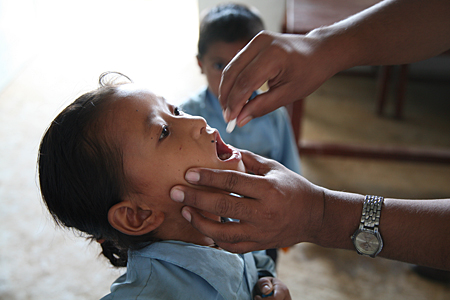C
 Return to Index page
Part
1 Transcript of Part 1
Return to Index page
Part
1 Transcript of Part 1 (includes slides)
Part
2 Transcript of Part 2 (includes slides)
Part
3 Transcript of Part 3 (includes slides)
Part
4 Transcript of Part 4 (includes slides)
Part
5 Transcript of Part 5 (includes slides)
Presentation
downloads
Supporting material:
Environmental
classification of water- and excreta-related diseases [
JEE,
ASCE, 1999]
Parasite life cycles Scabies
Trachoma
 |
Ascaris lumbricoides worms recovered
from a five-year old Bangladeshi child
Courtesy of Dr Andrew Hall
University of Westminster
|
 |
[DCPP, 2008]
See also: Action
Against Worms (WHO newsletters)
|
Sanitation and Disease [John Wiley & Sons, 1983]
Drawers of Water: Domestic Water Use in East Africa [Chicago UP, 1972] − the
book that introduced the concept
of water-washed disease. University
of Leeds
Library
catalogue entry.
Manson's Tropical Diseases, 22nd ed. (Saunders, 2009) Univ.of Leeds Library catalogue entry.
A Short Textbook of Public Health Medicine for the Tropics,
4th ed. (Arnold, 2003) − link to
free download.
A Community Guide to Environmental Health (Hesperian
Foundation, 2008)
Dynamics and control of
infections transmitted from person to person through the environment
(American
Journal of Epidemiology, 2009)
Video: Can
we domesticate germs? (Ted Talks, 2007) − Professor Paul Ewald on the
evolutionary control of diarrhoeal disease pathogens and more.
Estimating the burden of disease from water, sanitation, and
hygiene at a global level
[
EHP, 2002]
Diarrhoea: why children are still dying and what can
be done [UNICEF/WHO, 2009]
Diarrhoea kills over a million over-fives each year [Science
and Development Network, 2009]
The
global burden of diarrhoeal disease [
Bull.
WHO, 2003]
Practical guidance
for assessment of disease burden at national and local levels [WHO webpage,
with links to all reports in the Environmental Burden of Disease
Series − see Report #15: Water,
sanitation and hygiene: Quantifying the health impact at national
and local levels in countries with
incomplete water supply and sanitation
coverage]
Etiology and epidemiology of diarrhea in
children in Hanoi, Vietnam [International Journal of
Infectious
Diseases, 2006] Conclusions: “Group A rotavirus, diarrheagenic
Escherichia coli, Shigella spp, and enterotoxigenic Bacteroides fragilis
play an
important role in causing diarrhea in children in Hanoi, Vietnam.
Epidemiological
factors such as lack of fresh water supply, unhygienic septic
tank, low family
income, lack of health information, and low educational level
of parents could
contribute to the morbidity of diarrhea in children.”
Estimating child mortality due to diarrhoea
in developing countries [Bull. WHO, 2008]
“Findings: Global
deaths from diarrhoea of children aged less than five were
estimated at 1.87
million (95% confidence interval, CI: 1.56–2.19), approx-
imately 19% of total
child deaths. WHO African and South-East Asia regions
combined contain 78%
(1.46 million) of all diarrhoea deaths occurring among
children in the developing world; 73% of these deaths are concentrated in just
15 developing countries.”
Water, Sanitation,
and Hygiene Improvement Training Package for the Prevention of Diarrheal
Disease (USAID, 2009) − this Training Package consists of
three separate parts:
(1) a step-by-step Guide
for Training Outreach Workers, (2) an Outreach
Worker's Handbook for community outreach workers to use during and after
training, and (3) a Collection of
Resource Materials to use as a source for visual
aids.
► Early childhood diarrhoea and helminthiases associated with
long-term linear growth faltering
[
International
Journal of Epidemiology, 2001]
► Effects of stunting,
diarrhoeal disease, and parasitic infection during infancy on cognition in late
childhood: a follow-up study [The Lancet,
2002]
► Heavy schistosomiasis associated with poor short-term memory and slower
reaction times in
Tanzanian schoolchildren [TM&IH,
2002]
► Hookworm, Ascaris lumbricoides infection
and polyparasitism associated with poor cognitive
performance in Brazilian
schoolchildren [Tropical Medicine & International Health, 2008]
Oral rehydration [and more]
The Global Burden of Disease [Executive Summary of Volume 1,
Harvard University
Press, 1996]
Global Burden of Disease and
Risk Factors [World Bank, 2006]
Environmental Burden
of Disease: Country Profiles [WHO, 2007]
Short- and long-term effects of bacterial gastrointestinal infections
(
EID, 2008)
− increased
risk of aortic
aneurysm within 12 months of Salmonella infection, elevated risk
for ulcerative
colitis within 12 months of Salmonella and Campylobacter
infections,
and increased risk for reactive arthritis within 12 months of Yersinia,
Salmonella and Campylobacter infections.
Preventing disease through healthy environments: Towards an
estimate of the environmental
burden of disease [WHO, 2006]
Disease and Mortality in Sub-Saharan Africa (2nd edition) [World
Bank, 2006] − Chapter 9:
Diarrheal diseases; chapter 14: Malaria; chapter 15:
Onchocerciasis
The South African
National Burden of Disease Study 2000: Estimates of Provincial
Mortality
[SAMRC, 2006]
Summary Report
Water, Sanitation and Hygiene: Interventions and Diarrhoea
[World Bank, 2004]
Health, Environment and the Burden of Disease: A Guidance Note
[DFID, 2003]
Environmental Health and the Poor: Our Shared Responsibility
[WELL, 2005]
Environmental
determinants of infectious and parasitic diseases [
Mem. Inst. Oswaldo
Cruz, 1998]
Perceptions of a literate community regarding causation,
presentation and treatment practices of
intestinal worms among children [Journal of the College of Physicians and Surgeons of
Pakistan,
2007]
Interventions for the control of diarrhoeal diseases among
young children: improving water supply
and excreta disposal facilities [
Bull.
WHO, 1986]
Disease Control Priorities in Developing
Countries, 2nd ed. [World Bank, 2006]
DCP Home Page
Diarrheal diseases
Soil-transmitted
helminth infections and schistosomiasis
Water supply,
sanitation, and hygiene promotion
Journal of Water and Health: homepage (free access in developing countries: details
here)
Progress against Neglected Tropical Diseases [Gates Foundation, 2009]
Epidemics after natural disasters [EID, 2007]
The SAFE strategy for trachoma control [
Bull. WHO, 2006] "SAFE" =
surgery,
antibiotic
therapy,
facial cleanliness, and
environmental improvements.
Water obviously important!
The Top Ten Causes of Death 2002 [WHO, 2007]
Growing problem of multidrug-resistant enteric pathogens in Africa [
EID, 2007]
►Partial abstract: “Control of fecal–orally
transmitted pathogens is inadequate
in many developing countries, in
particular, in sub-Saharan Africa. Acquired
resistance to antimicrobial drugs is becoming more prevalent among Vibrio
cholerae, Salmonella enteritidis, diarrheagenic Escherichia coli,
and other
pathogens in this region. The poor, who experience most of the
infections
caused by these organisms, bear the brunt of extended illness and
exacerbated proportion of deaths brought about by resistance.” Prevention
clearly better than cure − so water, sanitation
& hygiene education!
Health and wealth: Improved health does not always make
countries richer (The Economist,
2008) [page 3 of the pdf file has links
to the references given on page 2]
The Mills-Reincke phenomenon:
Sedgwick,
W. T. and Macnutt, S. (1908). An examination of the theorem of Allen Hazen that
for every death from typhoid fever avoided by the purification of public water supplies, two
or three deaths are avoided from other causes. Science 28 (711), 15–16.
See also: Hygiene and Hygiene Education
Information on specific water- and
excreta-related diseases:
A-Z Index [Centers for Disease Control and
Prevention]
Water- and sanitation-related diseases fact sheets
[WHO, 2004]
Map of global
childhood diarrhoea, 2006
Diarrhoea case management in low- and middle-income
countries − an unfinished agenda
[Bull. WHO,
2007] (The
data in this paper suggest
that ‘cure’ is at best
imperfect − so why not go
for ‘prevention’ by improved
water supplies
and sanitation?)
Rotavirus [
EID,
Oct.-Dec. 1998]
Global illness and deaths caused by rotavirus disease in
children [
EID, May 2003]
Rotavirus and severe childhood diarrhea [
EID, Feb. 2006]
Sapovirus in water, Japan [
EID, 2007]
Cholera
On the Communication
of Cholera [John Snow, 1854]
See also History.
Map of global cholera cases, 2003
Human campylobacteriosis in developing countries [
EID, March 2002]
Cryptosporidiosis: an emerging, highly infectious threat
[
EID, Jan.-Mar. 1997]
Update on Cyclospora cayetanensis, a food-borne
and waterborne parasite [Clinical
Microbiology Reviews, 2010]
Helminths
Global Atlas
of Helminth Infections (website, London School of Hygiene and Tropical Medicine
and Partnership for Child Development) − an open-access information resource on the
distribution of
soil-transmitted helminths and schistosomiasis
Malaria
Global Malaria Programme [WHO
website]
Malaria [The Global Fund, 2006]
Malaria [Disease Control Priorities Project, 2006]
Map of global malaria cases, 2003
Engineers and malaria: part of the solution, or part of the
problem? [E&U, April
1999]
Hitting malaria where it hurts: household and community responses
in Africa [id21, 2006]
Malaria, mosquitoes and the legacy of Ronald Ross [Bull.
WHO, 2007)]
Case
Studies from
Millions Saved: Proven Successes in Global Health [Center
for Global
Development, 2004]:
Controlling trachoma in Morocco
Preventing diarrheal deaths in Egypt
Controlling onchocerciasis in sub-Saharan Africa
Soil-transmitted Helminthic Infections: Updating the Global
Picture [DCPP, 2003]
Prevalence and risk
factors for soil-transmitted helminth [STH] infection in mothers and their
infants in Butajira, Ethiopia: a population based study [BMC Public Health, 2010]
– “Daily
use of soap and a safe supply
of water are likely to reduce the risk of STH
infection”.
‘End in sight’ for
elephantiasis [BBC News, 2008]
Trachoma
Epidemiology
and control of trachoma: Systematic review [TMIH,
2010]
Comparing the effectiveness of
shared versus private latrines in preventing trachoma in rural
Tanzania [Am. J. Trop. Med. Hyg., 2010] – “Latrine use was
associated with a
decreased risk of trachoma and there was no difference in
risk between
households using shared compared with private latrines. This study
emphasizes the need to promote latrine use, which can be facilitated through
latrine sharing in resource scarce areas, for prevention of trachoma.”
Zambia – Toilets save eyesight [Sanitation
Updates, 2009]
Trachoma [
The Lancet, 2008]
Podcast: Focus on Trachoma [
The Lancet
, 2006, mp3 file]
Evaluation of the
prevalence of trachoma 12 years after baseline surveys in Kidal Region,
Mali
[Tropical Medicine &
International Health, 2010]
Tanzania's fight against onchocerciasis [The Lancet, 2008]
Distance to water source and altitude in relation to active trachoma
in Rombo district, Tanzania
[
Tropical Medicine & International Health,
2006]
Guinea Worm − the
first waterborne and first parasitic disease to be very close
to extinction:
3.5m cases in 20 countries in Sub-Saharan Africa and South Asia
in 1986;
<5000 cases in six countries in Africa in 2008.
Guinea Worm
Eradication Program [Carter Center webpage] − watch the videoclip!
Guinea worm wrap-up #177 [CDC, 2007]
Foul Water / Fiery Serpent − a film on guinea
worm [Cielo
Productions, 2010]
See also: Climate change
Listen
Trouble on tap [
Cryptosporidium]
(MicrobeWorld Radio,
2006)
The ocean and cholera (MicrobeWorld Radio,
2006)
The Forgotten Plague:
Malaria [four programmes] (The World, 2005)
River blindness in Sierra Leone [onchocerciasis] (The World, 2007)
Recreational
Waters
Guidelines for Safe Recreational Waters: Vol. 1 Coastal &
Fresh Waters [WHO,
2003]
Protecting public health from the impact of body-contact
recreation [
Water Science
and Technology, 2006]
A sea change ahead for recreational water quality criteria [
JWH, 2009]
See also: Microbial source tracking
and listen to ... Poo-poo in the prawn
Book (for purchase
only):
Merde: Excursions in Scientific, Cultural, and Socio-Historical
Coprology [Random
House, 1999]
 |
Supercourse (WHO Collaborating
Center, University of Pittsburgh) − Supercourse is a global repository of
lectures on global health and prevention (over 3500 lectures in 26 languages and
downloadable for free).
|
CIC

